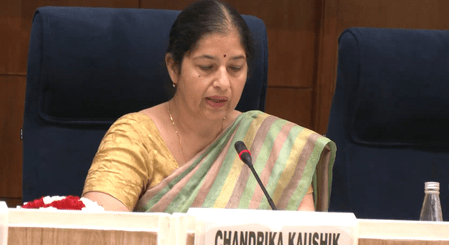
Director General of Defence Research and Development Organisation (DRDO), Dr Chandrika Kaushik, on Tuesday said technology is playing the role of force multiplier in the country’s ‘zero casualty’ approach in disaster response, that has earned global recognition.
Speaking at the Annual Conference of the Relief Commissioners and Disaster Response Forces, the DRDO DG said, “At DRDO we have resolved to develop systems and technologies that not only empower our forces but also enable the other agencies in the Ministry of Home Affairs and communities to prepare, respond and recover from disasters more effectively.”
“Technology is the most powerful ally today in our preparedness for disaster management. Drones are being used extensively for aerial surveillance and damage assessment. Even in the last mile delivery of essential supplies in inaccessible zones,” said DRDO DG (Production Coordination and Services Interaction).
Dr Kaushik said Artificial Intelligence and Machine Learning are enabling predictive modelling of disaster patterns, rapid analysis of satellite imagery and real time social media monitoring for situational awareness.
Referring to a co-speaker’s presentation on an App for predicting lightning, she said, “We have made a similar App for predicting avalanches that is required by the armed forces in glaciers.”
She said, “If required, this can be made available to various state agencies for improving disaster warnings issued to people.”
“The Internet of Things (IoT) with embedded real censors is helping us monitor the health of responders and victims during disaster,” she said, highlighting the increasing use of robotics in search and rescue operations and geospatial technology in evacuation.
Talking about uninterrupted connectivity through satellites, she said “together the use of these technologies in an integrated manner is enhancing our capacity to respond to disasters in real time.”
She said over the years the country’s disaster response has moved from relief-driven to “proactive, integrated and outcome-focussed” with zero casualty as a national goal.
On Monday, Union Home Minister Amit Shah hailed the launch of an Integrated Control Room for Emergency Response (ICR-ER), National Database for Emergency Management Lite 2.0 (NDEM Lite 2.0), and Flood Hazard Zonation Atlas of Assam.
He said in a post on X, “It will equip our disaster management apparatus with the speed and precision of new-age technologies.”
The ICR-ER will prompt real-time response to disaster across the nation by streaming satellite data to rescue agencies, and the NDEM Lite 2.0 will provide our response forces spread across nooks and corners with the agility to confront any calamity as a single unit, he said.
“The atlas of Assam will guide our flood control authorities to realise the goal of flood mitigation by providing them with the instant data related to floods, their impact, and water levels in rivers,” HM Shah said.











